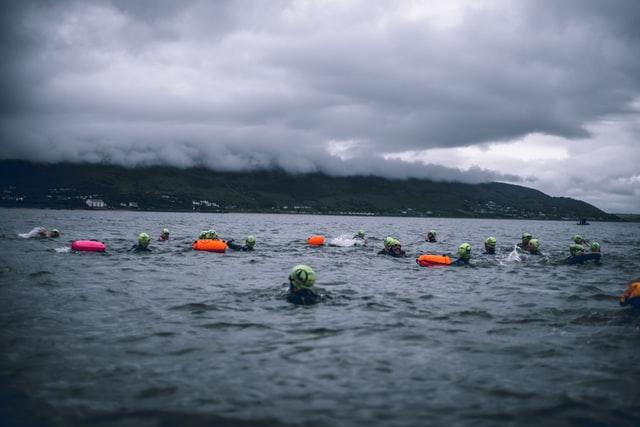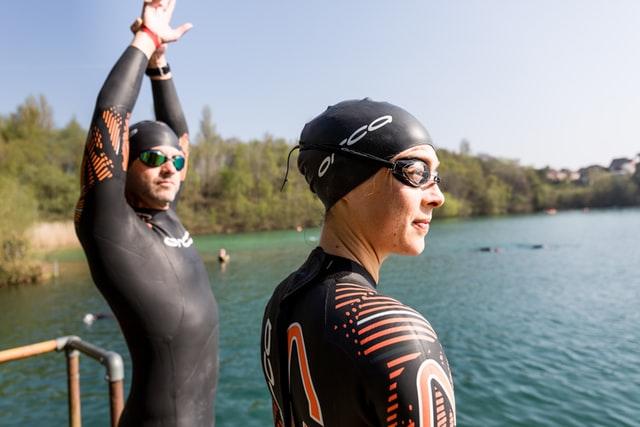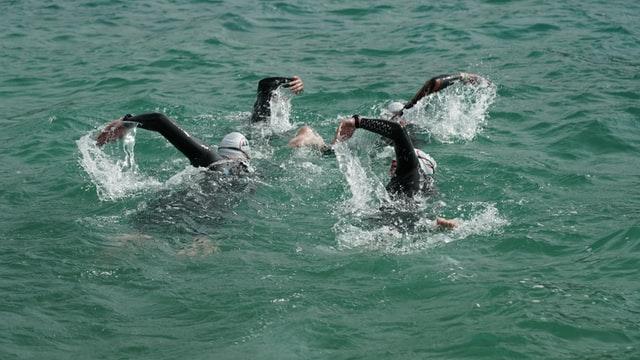Olympic Open Water Swimming: Everything You Need to Know
As of 2008, open water swimming is an official sport that countries around the world can compete in at the summer Olympics every 4 years.
Because this sport is so new, you may be wondering how it works and what rules the athletes need to follow. Read on to learn more about this unique sport and what you would need to do to become an Olympic open-water swimmer.

How Olympic Open Water Swimming Works
Olympic open water swimming is a true race in that the swimmers compete against one another and the first one to the finish is the winner. This is much different than other Olympic swimming events as in those the swimmers utilize a pool and the swimmer with the lowest time on the clock wins.
Because the open water swim is performed outside, this adds an extra layer of challenge to the event. Open bodies of water have varying conditions from currents to tides that aren’t found in a swimming pool. No to mention that you may come into physical contact with another swimmer as there are no lane ropes to keep the athletes separate from one another.
But they also have some positives too, one of which is that you don’t have to waste time and energy turning around as you often do in lap swimming. Don’t rejoice just yet however as many courses are in a circle meaning the athlete will have to do a couple of rounds of the same path in order to finish.
What Distance is the Olympic Open Water Swim?
The Olympic Open Water Swim is always a distance of 10km, but in order to get to the Olympic 10km swim level, you will need to be comfortable swimming at other distances in other international meets. Open water swim events around the world can have distances of 5km, 10km, and 25km.

How to Become an Open Water Swimmer
As you can imagine, there is a lot of technique involved in becoming an open water swimmer who is proficient enough to compete in the open water Olympics. It will take years of practice and lots of dedication on your end.
Here are the steps to becoming an open water swimmer (we can’t guarantee you will make it to the marathon swim Olympics though!)
Step 1: Build Endurance
Unlike the pool, there is no way to easily take a break in open water swimming. If you get tired when you are in the middle, you will have to swim back in order to take a break. This is why, before you attempt open water swimming, you need to build your endurance in a regular pool first.
Start by swimming the distance of your open water swim in the pool first. Remember that the pool will be the easiest place to swim that distance. If you can swim the entire distance without stopping, plus a few extra laps, then you are ready for an open water swim.
Step 2: Practice In Motion Resting
As mentioned above, you can’t rest during an open water swim. But what you can do is perform your strokes in smaller versions, or learn the side crawl, which is a rest stroke. Either of these will let you breathe as you swim even though you don’t have somewhere to stand or a side to grab onto.
Step 3: Practice Your Breathing
In the pool, it doesn’t matter too much how and when you are breathing, but in the open water, it can make all the difference.
You need to ensure you are able to breathe on both sides of your body, as well as go a bit longer if you are unable to breathe in your normal pattern. You never know when there may be waves or other situations that require that you skip a breath or try the other side.
Step 4: Stop Pushing Off
In the open water, you will not have a wall to push off of when you turn to give you a boost. Remember the practice distance you are swimming in step one? Do that without pushing off the wall. It’s harder and it will take longer and more energy, but you will be prepared when you finally get to the open water.
Step 5: Practice Swimming With Your Eyes Closed
While you will have your goggles when you head out into the open water, this doesn’t guarantee that you will actually be able to see anything. Many lakes are murky and it can be difficult to gauge your distance or where you are at on your swim.
Stimulate this by swimming in the pool with your eyes closed for a few laps, only opening them above water. This will give you the same feeling as if you were unable to see the bottom on an open swim.
Step 6: Practice all Strokes
While you may love freestyle, this may not be enough to get you through an open water swim. Practice varying your strokes from time to time because you never know what the open water conditions may call for.
Step 7: Practice Swimming for Landmarks
When you pick your spot for your open water swim, you will need a location where there are landmarks to swim towards. This is because otherwise you may lose your direction and drift off course due to tides or waves.
You’ll also need to practice this in the pool ahead of time as it can be easy to get in your groove and not notice what is going on outside the water. Practice looking up as you make each turn as if you were searching for your landmark.
Step 8: Buy a Wetsuit
By now you’re probably well trained and ready to jump into the nearest lake. Not so fast, however, as you will need a wetsuit to be successful as an open water swimmer.
Open water is cold, and when you get in cold water it is your body’s natural reaction to tense up. While you will need to do some breathing practice to help this, you should also purchase a wetsuit designed for open water swimmers to help keep your body warm.
Step 9: Get a Buddy
Open water swimming is dangerous, and before you take the dive you need to find a buddy who will be there with you. It could be someone who likes to paddleboard, kayak or has a canoe.
This way they will be there with you as you conquer open waters. They can also pull you out if there is an emergency. Start practicing with them from the start and have them film you as well so you can take a look at your form and make changes to improve how quickly you swim.
Step 10: Practice Practice Practice
Now comes everyone’s least favorite part. Practice. You should be swimming in open water every weekend if you can and you should be in the pool at least two other days during the week.
Once you think you are ready, sign up for a local competition or join a swim team and see how you do. And remember, if you don’t succeed the first time you can try again.

Is Open Water Swimming Difficult?
Open water swimming is extremely difficult and many professionals will tell you that distances in the open water will take you two or three times as long as they do in the pool. To become an open water swimmer you need to have endurance far beyond what you normally need to swim in a pool.
You also need to have courage and be able to relax even if things aren’t always going your way. Swimming in open water is unpredictable and can sometimes be a challenge for the most experienced swimmers.
Training Exercises for Open Water Swimmers
Once you get used to swimming in the open water it’s time to practice. You will want to practice swimming your desired distance over and over again. Practice it in different bodies of water and in different conditions as you never know what the conditions will be on the day of your event.
It’s best if you start with 5k, work on perfecting that first, then work your way up to the longer distances. As mentioned above you should aim to do an open water swim at least once a week, and try to go to different locations from time to time.
You will also want to take some time to try different wetsuits. While the thicker ones will keep you warmer, you may find they restrict your movement too much as you swim. If you are specifically training for a triathlon swim, you will want to pair your swimming with biking and running as well.
After a while, open water swimming will get easier, and before you know it, you’ll be a pro!
Link/Reference This Article
If you found the information in this article useful in your research, please link to use as the source using the tool below.
-
<a href="http://seatemperatures.net/blog/olympic-open-water-swimming/">Olympic Open Water Swimming: Everything You Need to Know</a>
-
"Olympic Open Water Swimming: Everything You Need to Know". SeaTemperatures.net. Accessed on April 25, 2024. http://seatemperatures.net/blog/olympic-open-water-swimming/.
-
"Olympic Open Water Swimming: Everything You Need to Know". SeaTemperatures.net, http://seatemperatures.net/blog/olympic-open-water-swimming/. Accessed 25 April, 2024
-
Olympic Open Water Swimming: Everything You Need to Know. SeaTemperatures.net. Retrieved from http://seatemperatures.net/blog/olympic-open-water-swimming/.